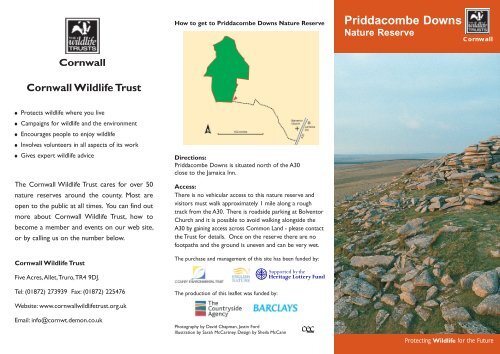Priddacombe Downs Nature Reserve - Cornwall Wildlife Trust
Priddacombe Downs Nature Reserve - Cornwall Wildlife Trust
Priddacombe Downs Nature Reserve - Cornwall Wildlife Trust
- No tags were found...
You also want an ePaper? Increase the reach of your titles
YUMPU automatically turns print PDFs into web optimized ePapers that Google loves.
How to get to <strong>Priddacombe</strong> <strong>Downs</strong> <strong>Nature</strong> <strong>Reserve</strong><strong>Priddacombe</strong> <strong>Downs</strong><strong>Nature</strong> <strong>Reserve</strong><strong>Cornwall</strong><strong>Cornwall</strong><strong>Cornwall</strong> <strong>Wildlife</strong> <strong>Trust</strong>Protects wildlife where you liveCampaigns for wildlife and the environmentEncourages people to enjoy wildlifeInvolves volunteers in all aspects of its workGives expert wildlife adviceThe <strong>Cornwall</strong> <strong>Wildlife</strong> <strong>Trust</strong> cares for over 50nature reserves around the county. Most areopen to the public at all times. You can find outmore about <strong>Cornwall</strong> <strong>Wildlife</strong> <strong>Trust</strong>, how tobecome a member and events on our web site,or by calling us on the number below.<strong>Cornwall</strong> <strong>Wildlife</strong> <strong>Trust</strong>Directions:<strong>Priddacombe</strong> <strong>Downs</strong> is situated north of the A30close to the Jamaica Inn.Access:There is no vehicular access to this nature reserve andvisitors must walk approximately 1 mile along a roughtrack from the A30. There is roadside parking at BolventorChurch and it is possible to avoid walking alongside theA30 by gaining access across Common Land - please contactthe <strong>Trust</strong> for details. Once on the reserve there are nofootpaths and the ground is uneven and can be very wet.The purchase and management of this site has been funded by:Five Acres, Allet, Truro, TR4 9DJ.Tel: (01872) 273939 Fax: (01872) 225476The production of this leaflet was funded by:Website: www.cornwallwildlifetrust.org.ukEmail: info@cornwt.demon.co.ukPhotography by David Chapman, Justin FordIllustration by Sarah McCartney. Design by Sheila McCannProtecting <strong>Wildlife</strong> for the Future
<strong>Priddacombe</strong> <strong>Downs</strong> <strong>Nature</strong> <strong>Reserve</strong> on the northernpart of Bodmin Moor is over 200 acres in size.Bodmin Moor forms the only upland massif in<strong>Cornwall</strong> and is the most south-westerly upland inthe United Kingdom. The Moor was unglaciated butperiglacial erosion created the tors and clitter slopes.A large Bronze Age platform cairn sits at the highestpoint (310m) of <strong>Priddacombe</strong> <strong>Downs</strong> and from herethe nature reserve slopes gently northward falling onits western side to the valley marsh of the De LankRiver, the tributaries of which mark the lowernorthern and eastern boundaries of the reserve.From here clitter-strewn slopes rise north to BrownWilly <strong>Cornwall</strong>'s highest point at 420m.<strong>Priddacombe</strong> <strong>Downs</strong> has a long history of human occupation.The Bronze Age platform cairn and a number of standingstones form part of the extensive Bodmin Moor prehistoriclandscape. Nationally, there are under 250 known examplesof platform cairns and therefore the well preserved exampleat <strong>Priddacombe</strong> is very important hence its designation as aScheduled Monument.The time of most activity on the <strong>Downs</strong> appears to havebeen the post-medieval period. Moorland intake followed thepurchase of the area by Francis Rodd who leased out a seriesof 20 acre smallholdings. A small settlement called Round/Barber's Hill was established by 1841 and one of the manyareas of turf cutting is associated with this.Turf cutting exploited the blanket bog that covers part of thedowns and provided an important fuel source for the tenants.The areas of turf cutting can still be seen today along withevidence of the areas industrial past in the form of oldstreamworks. A number of heaps are present in the north ofthe reserve and these relate to alluvial streamworking for tin.A <strong>Nature</strong> <strong>Reserve</strong>The nature reserve, owned freehold by the <strong>Cornwall</strong> <strong>Wildlife</strong><strong>Trust</strong>, was purchased in 2001 with funding from the HeritageLottery Fund, English <strong>Nature</strong>, the County Environmental <strong>Trust</strong>and donations from members. It was acquired by the <strong>Trust</strong>for a large number of important features such as theScheduled Ancient Monument but in particular because theland, designated a Site of Special Scientific Interest, had beendegraded by past management.Agricultural policy since the Second World War tendedtowards production with subsidies encouraging farmers tohave large numbers of stock. This resulted in parts of BodminMoor becoming overgrazed and this was certainly true at<strong>Priddacombe</strong> <strong>Downs</strong>. Since purchasing the site a new grazingregime has been introduced with fewer cattle grazing atspecific times of year.With fewer cattle grazing the <strong>Downs</strong> the main habitats ofvalley mire and acid grassland are developing a morestructured cover of vegetation. A tussocky sward is beneficialto skylark and snipe that use the site and increases indifferent layers of scrub is good for stonechat, linnet andgrasshopper warbler that have all been recorded here.In some of the wetter areas there are dense patches ofMarsh fritillarypurple moor-grass and increased grazing is actually requiredhere. This can be achieved by carefully targeted winterburning that results in flushes of new grass in the spring thatis more palatable to the cattle. Halting the dominance ofpurple moor-grass is important for species such as the raremarsh fritillary butterfly that requires a patchwork of shortvegetation and long tussocky grass.The reduction in cattle should prevent the nutrientenrichment of the sites watercourses. Small tributaries of theDe Lank River border the site. The river which eventuallyflows into the River Camel is important for its otterpopulation.Photo: The slopes of Rough Toron Bodmin Moor
IExploring the moors...The nature reserve lies within an Area of Outstanding Natural Beautyand weather permitting can provide spectacular views. In the heartof the site a true sense of wilderness prevails and there is much tobe explored. There are no formal trails at <strong>Priddacombe</strong> <strong>Downs</strong> andthe visitor is free to walk the whole site. Indeed following theCountryside and Rights of Way Act 2000 larger areas of 'Access Land'will open up but visitors should consult the relevant authority beforeventuring beyond the nature reserve.IAccess track from A30 (walkers only)<strong>Nature</strong> reserve entranceInformation Board
















